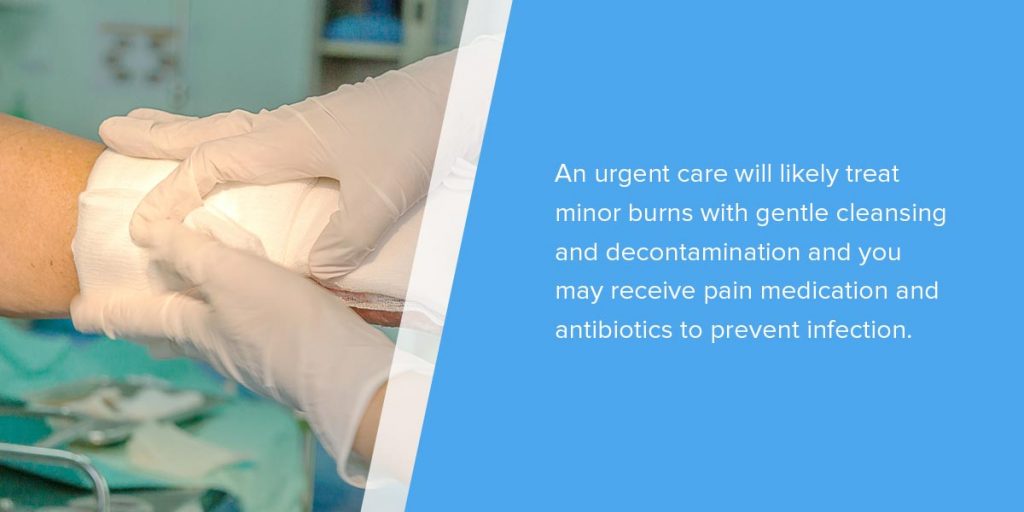
Reviewed by: Amy Surdam
Whether you fell asleep at the beach or had a grilling accident, burns can be a painful part of anyone’s summer. While you can care for some burns at home with first aid, others may require immediate medical attention. So how do you know the difference?
Learn the types of burns and when to go to urgent care for burns below.
A burn’s severity depends on the amount of damage it causes. Knowing how to assess burns and their seriousness can help keep you and your family safe. By learning to identify them, you can determine whether your burn warrants a trip to urgent care or the emergency room (ER).
First-degree burns are minor and only affect the outer layer of the skin, causing swelling, redness and pain. You might experience a first-degree burn if you briefly touch hot water or a hot pan. Mild sunburns are also an example of first-degree burns. Whatever the cause, you’re most likely to experience dry, peeling skin and pain that should be gone within 48 hours.
You won’t necessarily need to see a health care provider for these burns. A cool compress, ointment and lotions can treat first-degree burns and reduce the swelling, while acetaminophen or ibuprofen can help reduce pain. If your pain and symptoms last longer than 48 hours, you should go to an urgent care to have a health care provider examine the affected area.
Second-degree burns damage the outer and second layers of skin — if you get painful red or blotchy skin and a blister from a burn, it may be second-degree. A second-degree sunburn will swell up and blister for several days. It’s also typically more painful and takes longer to heal.
You should seek medical attention if you notice any redness, oozing, fever or increasing pain. Health care providers know how to treat second-degree burns, especially for burns on the hands, feet, face or groin.
Third-degree burns are severe, damaging both layers of the skin as well as the subcutaneous fat layer between the muscle and skin. A third-degree burn will be dry and leathery and appear red, bronze or brown. Although they’re often very painful, severe burns may sometimes cause little pain if they destroy the nerves.
Fourth-degree burns are incredibly severe and affect the skin, subcutaneous fat, muscle and even bone.
Regardless of the type of burn, some situations require medical care. You should seek immediate medical assistance if you notice:
You should never attempt to treat a third or fourth-degree burn on your own. It’s essential to seek immediate medical care to avoid severe complications, such as infections, dehydration, blood loss, muscle contractions, sepsis and damage to the nervous system.
While it’s easy to see why severe burns need rapid medical treatment, others may not be quite as obvious. If you’re unsure, it’s best to visit an urgent care to be safe. Urgent care centers are an excellent choice if your burn isn’t severe enough to warrant a trip to the ER. Health care providers will know how to treat a burn to help you feel better.

When you go to urgent care for burns, the provider will assess their severity. An urgent care will likely treat minor burns with gentle cleansing and decontamination and you may receive antibiotics to prevent infection. Most urgent care centers will provide initial care for first- and second-degree burns.
Since first-degree burns are less severe, you can treat them by:
If you have a severe burn:
The sooner you get treatment for burns, the sooner they will heal. The time it takes to heal completely will also depend on the type of burn:
Any type of burn can be uncomfortable and painful. While severe burns warrant a trip to the ER, you can receive excellent treatment for other burns at your local urgent care.
The health care providers at Coastal Urgent Care know what to do for burns to help you feel better. We offer comprehensive services and a dedicated team of professionals across 30 locations in Louisiana. Our team is highly experienced in treating all types of burns — as well as any complex health issues — to get you on the path toward recovery.
We strive to deliver personal care, ensuring your comfort every step of the way. Get in line online at a clinic near you.
